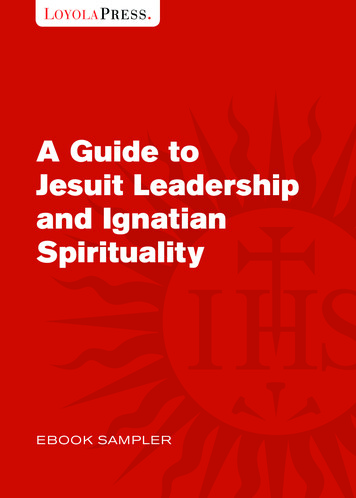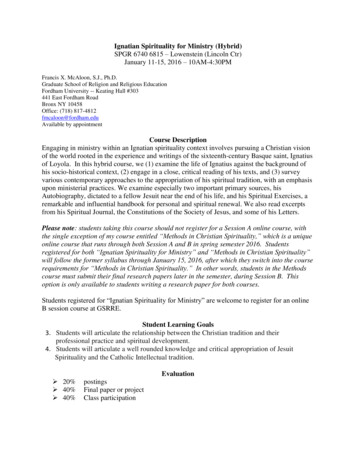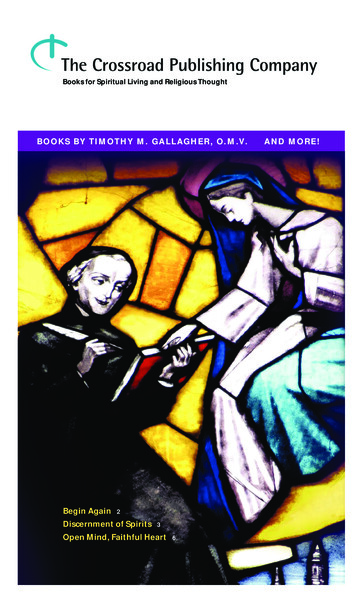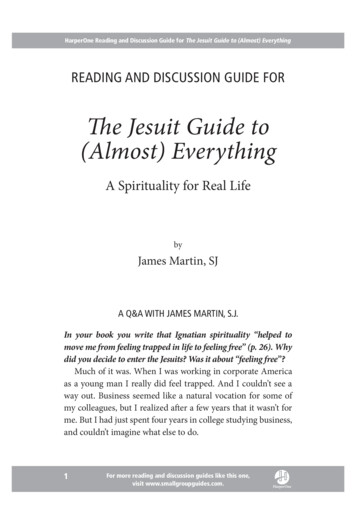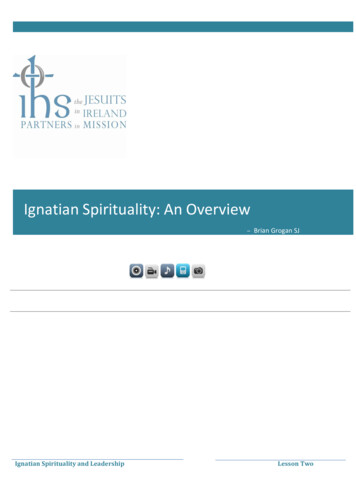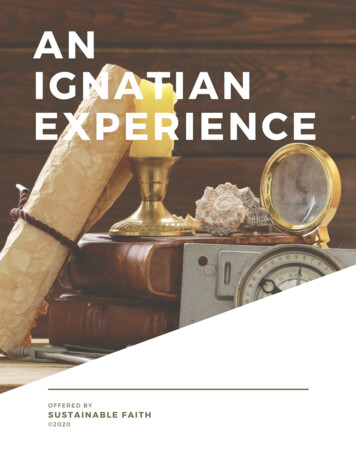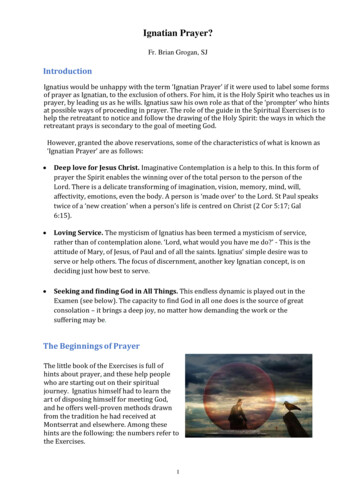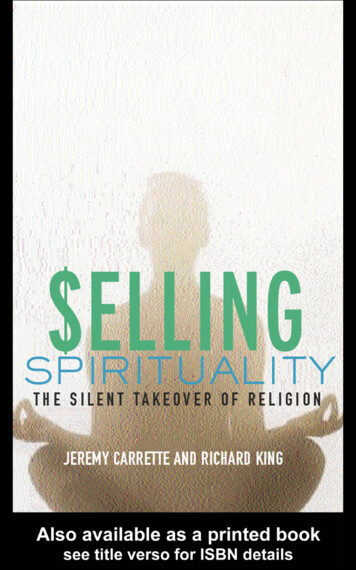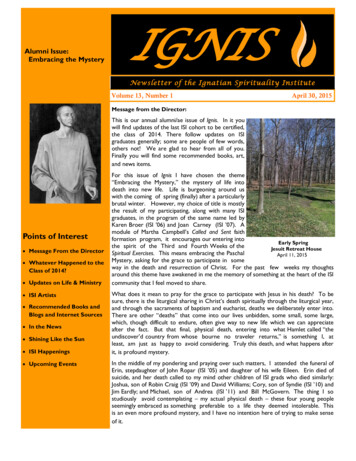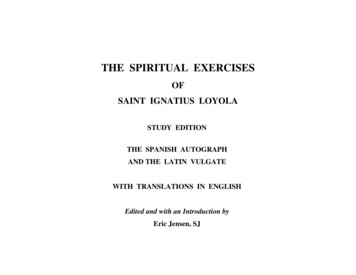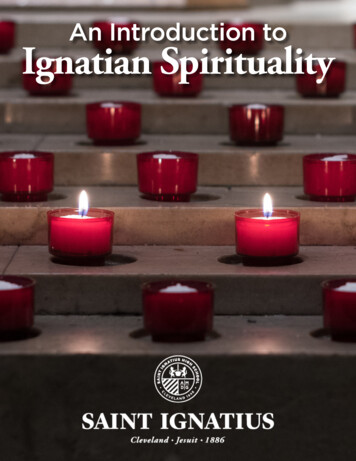
Transcription
An Introduction toIgnatian Spirituality
Session 1God, help me to beopen to you in thisretreat and in my life.
COME AS YOU ARECome as you arethat's how I want you.Come as you arebeing quite at home.Close to my heartloved and forgiven.Come as you arewhy stand alone?No need to fearlove sets no limits.No need to fearlove never ends.Don't run awayshamed and disheartened.Rest in my lovetrust me again.I came to call sinnersnot just the virtuous.I came to bring peacenot to condemn.Each time you failto live by my promise.Why do you thinkI'd love you the less?Don't run awayshamed or disheartened.Come as you arewhy stand alone.Come as you arethat's how I love you.Come as you aretrust me again.Nothing can changethe love that I bear you.All will be wellJust come as you are.by Paul Gurr, CarmeliteWeek 1 – Praying with St. IgnatiusJesuit Retreat House, Clevelandwww.jrh-cleveland.org
PRINCIPLE AND FOUNDATIONLord my God,When Your love spilled over Into creationYou thought of me.I am From loveof lovefor love.Let my heart, O God, alwaysRecognize,Cherish,And enjoyYour goodness in all of creation.Direct all that is me toward Your praise.Teach me reverence for every person, all things.Energize me in your service.Lord God may nothing ever distract me from Your love neither health nor sicknesswealth, nor povertyhonour nor dishonourlong life nor short life.May I never seek nor choose to beother than You intend or wish.Amen(Bergan and Schwan 1985)
SPA Library InformationPlease feel free to visit and browse the SPA Library located in the basementof St. Mary’s Chapel in room #8. There are a multitude of books onspirituality and prayer available to sign out for up to 30 days. Please feel freeto contact our office to see if we have a book that you may be interested inreading.Call Colleen Wyszynski at 216-961-2583, or email her atcwyszynski@ignatius.edu.
Ignatian VocabularyA.M.D.G. –Ad Majorem Dei Gloriam (Latin) - “For the greater glory of God.”A.M.D.G. is the motto of the Society of Jesus.Colloquy - A colloquy is an intimate conversation between you and God theCreator, between you and Jesus, or between you and Mary or one of the saints.Spiritual Consolation – Experienced when our hearts are drawn towards God,away from ourselves, even if this happens in circumstances the world would regardas negative. We experience an increase in hope, faith, and love and feel inharmony with God.Spiritual Desolation – Experienced when our hearts are drawn away from Godand towards ourselves and we experience a decrease in hope, faith, and love.Discernment (also “Discernment of spirits”) – A process for making choices, ina context of (Christian) faith, when the option is not between good and evil, butbetween several possible courses of action all of which are potentially good. ForIgnatius the process involves prayer, reflection and consultation with others- allwith honest attention not only to the rational (reasons pro and con) but also to therealm of one’s feelings, emotions and desires (what Ignatius called “movements”of the soul). A fundamental question in discernment becomes “Where is thisimpulse from- the good spirit (of God) or the evil spirit (leading one away fromGod)?” A key to answering this question, says Ignatius in his Spiritual Exercises,is that, in the case of a person leading a basically good life, the good spirit gives“consolation”- acts quietly, gently and leads one to peace, joy and deeds of lovingservice- while the bad spirit brings “desolation”- agitates, disturbs the peace andinjects fears and discouragement to keep one from doing good.
Encountering Christ- 8-week retreat – The name given the SIHS 8 WeekIgnatian Prayer Retreat (based on Ignatius’s Spiritual Exercises) organized by theSpirituality Programs for Adults (SPA) department.Ignatian Examen - A technique of prayerful reflection on the events of the day inorder to become aware of God’s presence in them.Finding God in All Things – Ignatian spirituality is summed up in this phrase. Itinvites a person to search for and find God in every circumstance of life, not just inexplicitly religious situations or activities such as prayer in church (e.g. the Mass)or in private. It implies that God is present everywhere and, though invisible, canbe “found” in any and all of the creatures which God has made. They reveal atleast a little of what their Maker is like- often by arousing wonder in those who areable to look with the “eyes of faith.” After a long day of work, Ignatius used toopen the French windows of his room, step out onto a little balcony, look up at thestars and be carried out of himself into the greatness of God.How does one grow in this ability to find God everywhere? Howard Gray drawsthe following paradigm from what Ignatius wrote about spiritual development inthe Jesuit Constitutions: (1) practice attentiveness to what is really there. “Let thatperson or that poem or that social injustice or that scientific experiment become(for you) as genuinely itself as it can be.” (2) Then reverence what you see andhear and feel; appreciate it in its uniqueness. “Before you judge or assess orrespond, give yourself time to esteem and accept what is there in the other.” (3) Ifyou learn to be attentive and reverent, “then you will find devotion, the singularlymoving way in which God works in that situation, revealing goodness andfragility, beauty and truth, pain and anguish, wisdom and ingenuity.”Ignatian - Adjective, from the noun Ignatius (of Loyola). Sometimes used indistinction to Jesuit, indicating aspects of spirituality that derive from Ignatius thelay person rather than from the later Ignatius and his religious order, the Society ofJesus.Ignatian Decision Making – The Ignatian approach to decision-making thatpresupposes we want to choose that which will lead to a deeper relationship withGod. Ignatian prayer and reflection helps us to achieve the detachment andbalance necessary to choose freely.
Ignatian Gospel Contemplation – A method of prayerful reflection on oneselfimaginatively inserted into the Gospel stories with Jesus in order to know, love andserve Him personally.Ignatian/Jesuit Vision, Characteristics of the - Drawing on a variety ofcontemporary sources which tend to confirm one another, one can construct a listof rather commonly accepted characteristics of the Ignatian/ Jesuit vision. It sees life and the whole universe as a gift calling forth wonder andgratefulness; gives ample scope to imagination and emotion as well as intellect; seeks to find the divine in all things- in all peoples and cultures, in all areasof study and learning, in every human experience, and (for the Christian)especially in the person of Jesus; cultivates critical awareness of personal and social evil, but points to God’slove as more powerful than any evil; stresses freedom, need for discernment, and responsible action; empowers people to become leaders in service, “men and women forothers,” “whole persons of solidarity,” building a more just and humaneworld.The relative consensus about these should not be taken to indicate that the sixcharacteristics exhaust the meaning of the living Ignatian tradition. Like theliving tradition of Christian faith, of which it is a part, no number of thematicstatements can adequately articulate it. At the heart of both traditions stands theliving person of Jesus, who cannot be reduced to a series of ideas.No one claims that any of these characteristics are uniquely Ignatian/ Jesuit. Itis rather the combination of them all and the way they fit together that make thevision distinctive and so appropriate for an age in transition- whether from themedieval to the modern in Ignatius’ time, or from the modern to the postmodernin ours.
IHS - The first three letters, in Greek, of the name Jesus. These letters appearas a symbol on the official seal of the Society of Jesus or Jesuits.Magis (Latin for “more”) - The “Continuous Quality Improvement” termtraditionally used by Ignatius of Loyola and the Jesuits, suggesting the spirit ofgenerous excellence in which ministry should be carried on. (See A.M.D.G.“For the greater glory of God.”)SPA (Spirituality Program for Adults) – The Spirituality Program for Adults(SPA) was developed at Saint Ignatius High School decades ago by Jim Lewis,S.J. as he shared Ignatian Spirituality with faculty, staff, parents of students andalumni. It is now the Spirituality Programs for Adults which offers 1)Encountering Christ 8 Week Retreat, 2) Ignatian Spiritual Exercises made inEveryday Life (Ignatius’s 19th Annotation Retreat made over 32 weeks, 3)Spiritual Direction/Guidance, 4) Faith-Sharing Groups, 5) Ignatian ReflectionGroups focused on an Ignatian topic, and 6) Peer Supervision and supports forthose sharing Ignatian Spirituality with others.spiritual exercises (small s and e) – Any of a variety of methods or activitiesfor opening oneself to God’s spirit and allowing one’s whole being, not just themind, to be affected. The methods- some of them more “active” and othersmore “passive”- might include vocal prayer (e.g., the Lord’s Prayer), meditationor contemplation, journaling or other kind of writing, reading of scripture orother great works of verbal art, drawing, painting or molding with clay, lookingat works of visual art, playing or listening to music, working or walking in themidst of nature. All of these activities have the same goal in minddiscontinuing one’s usual productive activities and thus allowing God to“speak,” listening to what God may be “saying” through the medium employed.The Spiritual Exercises (capital S and E) – An organized series of spiritualexercises put together by Ignatius of Loyola out of his own personal spiritualexperience and that of others to whom he listened. They invite the “retreatant”or “exercitant” to “meditate” on central aspects of Christian faith (e.g., creation,sin and forgiveness, calling and ministry) and especially to “contemplate” (i.e.imaginatively enter into) the life, death and resurrection of Jesus.
Ignatius set all of this down in the book of the Spiritual Exercises as ahandbook to help the guide who coaches a person engaged in “making theExercises.” After listening to that person and getting a sense for where he/sheis, the guide selects from material and methods in the book of the Exercises andoffers them in a way adapted to that unique individual. The goal of all this isthe attainment of a kind of spiritual freedom, the power to act- not out of socialpressure or personal compulsion and fear- but out of the promptings of God’sspirit in the deepest, truest core of one’s being- to act ultimately out of love.As originally designed, the “full” Spiritual Exercises would occupy a person forfour weeks full-time, but Ignatius realized that some people could not (todaymost people cannot) disengage from work and home obligations for that long atime, and so it is possible to make the “full” Exercises part-time over a periodof six to nine or 10 months- the “Spiritual Exercises in Daily Life.” In thatcase, the “exercitant,” without withdrawing from home or work, devotes aboutan hour a day to prayer (but this, like nearly everything in the Exercises, isadaptable) and sees a guide every week or two to process what has beenhappening in prayer and in the rest of his/her life.Most of the time people make not the “full” Spiritual Exercises but a retreat inthe Ignatian spirit that might last anywhere from a weekend to a week. Suchretreat usually includes either a daily individual conversation with a guide orseveral daily presentations to a group, as preparation for prayer/spiritualexercises.Ignatius had composed and revised his little book over a period of 25 or moreyears before it was finally published in 1548. Subsequent editions andtranslations- according to a plausible estimate- numbered some 4,500 in 1948 orabout one a month over four centuries, the total number of copies printed beingaround 4.5 million. It is largely on his Exercises- with their implications forteaching and learning in a holistic way- that Ignatius’ reputation as a majorfigure in the history of Western education rests.Spiritual Guidance/Direction – People are often helped to integrate their faithand their life by talking on a regular basis (e.g., monthly) with someone theycan trust. This person acts as a guide (sometimes also called a spiritual friend,
companion or director) for the journey, helping them to find the presence andcall of God in the people and circumstances of their everyday lives.The assumption is that God is already present there, and that another person, aguide, can help them to notice God’s presence and also to find words for talkingabout that presence, because they are not used to doing so. The guide is often aspecially trained listener skilled in discernment and therefore able to help themsort out the various voices within and around them. While he/she may suggestvarious kinds of spiritual exercises/ways of praying, the focus is much broaderthan that; it is upon the whole of a person’s life experience as the place to meetGod.19th Annotation – In Saint Ignatius of Loyola’s book of the Spiritual Exercises,written for directors guiding others, Ignatius writes 20 Annotations or helps. Inthe 19th Annotatation, Ignatius notes that for those unable to go to a retreathouse for 30 days of silent prayer, the Spiritual Exercises can be adapted andgiven over time for those who would be helped by them. The SpiritualExercises are adapted over 32 weeks and involve daily prayer, review of prayerand weekly meetings with a spiritual director.Hospitality, Welcome and Housekeeping Noteso ParkingThe best places to look for spaces are in the "Chapel Lot," which is located between
St. Mary's Chapel and the Fire Station, and in the Breen Center Lot, located on thesouth side of Lorain Avenue, just west of and - behind the Breen Center for thePerforming Arts. This lot can be accessed off both Lorain and West 30th. Both theselots welcome visitors. In previous years parking in the student lot across from SullivanGym during school hours was not allowed. Students need a permit to park there, andthe lot is usually full. This year security guards will allow you to park in anempty space if you tell them you are here for a SPA retreat. In the evening parkingis discouraged on Carroll Ave. and on W. 30th between Carroll and Bridge Avenues.We strive to maintain good relations with our neighbors! During the morning retreats,you may park on any side streets South of Lorain Ave. or in St. Patrick's Church lot at3602 Bridge Ave., a short walk to campus.Please refer to the parking map providedoBad WeatheroAbsenteesoRefreshmentsFor the morning retreat we follow the school schedule. If school is cancelled,(check our website) then SPA is cancelled. If school is scheduled for a delayedstart, please check your email, as I will contact you. Colleen will attempt to calleveryone in either situation.For the evening retreat, we will determine if the session should be cancelled due toweather. Please check your email to find out if we are meeting that evening.Colleen will also call retreatants if we decide to cancel the session.Please call/email your small group director or Colleen Wyszynski (216-961-2583)ahead of time, if possible. Attendance and fidelity to your prayer commitment isvital to your own and the group's retreat experience.Coffee, tea and bottled water will be available during breaksRestroomsRestrooms are located in the chapel basement. You can access them via the stairs orelevator located off the north end of the narthex.oRetreat ExpensesWe do not charge a fee for this retreat because we wish to make it available for allwho are called to make it. We will, however, ask for a free will donation near theend of the sessions to help defray the costs associated with putting on the retreat.Our retreat program uses a very small percentage of the total Saint Ignatius HighSchool budget. We use a small share of this building, the heating, cooling, officesupplies, computer, resources, parking lot, security, lighting and so on. This cost isless than 20 a week for each of you, about 150 for the entire retreat.
GUIDELINES FOR FAITH SHARING GROUPS1. Remember confidentiality.2. Practice unconditional acceptance / non-judgmental listening.3. Everyone is free to share from their unique life and prayer experience.4. Listen reverently and prayerfully to each other.5. Trust God’s presence and the Spirit’s guidance in the group.6. Leave problem-solving and teaching to God.7. Expect differences as your relationship within Sacred Mystery isunique. There’s no wrong way to pray.8. Silence is a part of the sharing process, full of God’s SelfCommunication.9. Share the time so all may fully participate.10. Practice loving one another as God loves.
Meet the Guide, by Margaret SilfIn my day job, I am writing a programmer's guide on how to overcome the problems in computer datamanagement when we enter the next millennium. How come, then, I am sitting here reflecting on theways in which the insights of a man who lived 450 years ago in a remote Basque village in northern Spainaffect the way in which we relate to God today, on the threshold of the 21st century? I sometimes thinkthat my PC will give a little shudder of culture shock when I expect it to process my thoughts on theproblems of two-digit notation and the search for my deepest desire at the same time.This coming together of two worlds apparently so far removed from each other is perhaps in itself apointer to some of the treasures that are ours today through the legacy of Ignatius Loyola and the Societyof Jesus, which he founded. If we can imagine his browsing through this book, or sitting among us as weexplore these questions together, he would quite likely be smiling to himself and muttering somethingabout "finding God in all things." He would find it completely normal and healthy that we should besearching to deepen our relationship with God in the midst of life as we really live it – up to our ears inwork or lack of it, mortgages, children, and mess. He would be delighted to find that most of us are laypeople, as he was when he made his own journey of discovery. He would surely welcome the fact that wecome from many different church traditions or even from none at all. And he would be more than tolerantof the checkered histories we may have behind us, remembering the excesses of his own misspent youth.Most of all, he would recognize the love of God that is burning inside each of us, that is always leading usonward, like a beacon, toward deepening our relationship with Him, because this would reflect theexperience of Ignatius' own heart and the source of his prodigious energy.So who was this man whose life and discoveries are still affecting our own journeys so fruitfully? Beforewe begin our journey proper, let's indulge for a few minutes in a time shift that takes us back to the agewhen Europe was in a similar kind of between-age turmoil to the one we are experiencing now. This newage isn't just causing havoc to our computer systems but also seems to include a heightened awareness inpeople everywhere (whether they call themselves religious or not) that there is more to life than the meremanagement of our days to achieve comfort and security in the shifting landscapes of our lives.Inigo Lopez lived at the time when the world was coming painfully and violently out of the Middle Ages.The mere facts of his life can be summed up in a few sentences; its content infinitely more far-reaching.He was born in 1491, the youngest of a family of 13, in Loyola, in the Basque region of northern Spain.When he was 14, he was sent away to train as a royal page to the king of Spain and was introduced to theideals of chivalry and knightly service. As he grew older, he developed more than a passing interest inwomen, both those far away in his daydreams, and those who were temptingly accessible. The last thingon his mind during these years was his spiritual journey or the inner movements of his heart.His life swerved around a big bend during his mid-twenties. The favor that his employer, Don JuanVelasquez, had enjoyed in the royal court came to an abrupt end at the death of the king. As a result, Inigohimself was unemployed, and chastened by his experience of how quickly and easily the power and richesand influence can disappear. With a parting gift of a few hundred crowns and two horses from the widowof his former employer, he had to set off into the unknown and start again.The next phase of his life was in the household of the duke of Najera, who employed him as a gentlemanat-arms. Inigo learned to use weapons and helped to put down rebellions. His military training under theduke brought him, four years later, to a place called Pamplona, where he commanded a companydefending the fortress there against a French invasion. The defense had become futile and defeat was acertainty, but Inigo was stubborn to the limits and absolutely refused to surrender. The price of hisresistance came in the form of a cannonball which shattered his leg and broke his right knee. His days asa soldier ended on a stretcher; he was transported in agony and humiliation across the mountains to hisfamily home in Loyola.It must have seemed like the end of the line. Probably most of us can identify with that drained, emptyfeeling of being at the end of our dreams and our resources, or helpless in pain or immobility, either in
body or in mind. We can imagine how it might have been for this young man, in the prime of his life, tolie a helpless invalid, wracked by pain, with nothing but his broken dreams for company. Sodaydreaming is just what he did.Having asked in vain for some lively romantic novels to read, Inigo had to make do with what the castlecould offer, which turned out to be a Life of Christ and a Lives of the Saints. This stricken and disgruntledpatient spent his time between reading and daydreaming of all that might have been, had his injury notrobbed him, in a stroke, of both his future as a soldier and his attractiveness to women.Daydreaming! Ironic that this man whose military skills and leadership potential were so remarkableshould have come down to us, most powerfully, as a daydreamer. But Inigo's daydreams held a potentsecret. They had, locked up inside them, the key to the gift of discernment. And how did Inigo discoverfor himself this key that was to open up a gold mine in his heart?As the tedious, pain-ridden days passed, Inigo indulged in two kinds of daydreaming. On the one hand,he still dreamed of the battles he would command, the military glories he would achieve, the noble ladieshe would woo and win. But they were the dreams of "what might have been," and though they raised hisspirits for a while, he enjoyed the fantasy, they left him, in the longer term, feeling flat and disconsolate.On the other hand, fired by the books he had been given, he started to dream of a King whose service waspotentially even more desirable than that of the king of Spain; he began to wonder how this Christ Kingmight be served; he began to dream of outsainting the saints in this great new quest that might be worthspending his life on. They were still daydreams, but he noticed an important difference in theiraftereffects. These dreams left him feeling inspired, energized and eager. They were not about whatmight have been, but about something that still lay dormant in the depths of his own heart, like a seed thathad been mysteriously germinated and was pushing its way to the surface of his life through all this heavysoil of pain and disappointment. These were dreams that didn't go away.It was into this realization of the difference between daydreams and God-dreams (as we might call them)that the gift of discernment was given to Inigo. It was there that he discovered what we might call the"inner compass" of his heart, which was able to reveal to him which movements within him were capableof engaging his deepest, vital energy, and which were leading him only to fleeting satisfactions that lefthim unchanged and unfulfilled. As he lay there in his enforced stillness and solitude, he learned to noticehis moods and feelings and reactions, and to measure them against this unseen compass. In his innersilence, he listened with fresh awareness to an invitation coming from deep inside himself to enlist in theadventure of the service of God.As he ventured more and more deeply into the stories that were inspiring his new kind of daydreaming, hewas also finding a new way of exercising his imagination. He began to find himself, in imagination,present in the scenes, conversations and stories of the Gospels, and he began to participate in the plots ofthese stories. It was the start, for him, of an adventure into imaginative prayer that was to become a mostpowerful catalyst for the growth of his personal relationship with God, a method of prayer that is just asvividly available to us today.On his sickbed, Inigo experienced deep conversion. Gradually, after many setbacks, he limped his wayback to life, but it was never again to be the life he had known before; the cannonball had blown that lifeto pieces. Now Indigo was a pilgrim to God, to whom he was ready to offer all his ideals of knightlyservice, courage and persistence. The next step was to tell his family.as for so many who have walkedthis path in their own personal ways since then (including, surely, many of you who are reading this booktoday), this wasn't easy! Against a backdrop of pressure to use his skills and gifts to bring honor to thefamily name and help maintain the family property, Inigo made his excuses and left, with neither he norhis family knowing with any certainty where he was headed. Inigo -the nobleman, the soldier, thefearless defender of Pamplona - had become Inigo the pilgrim.The first stage of his pilgrimage -that search for the "I know not what" that was urging him onwards -took Inigo to the Abbey of Montserrat, high on a jagged mountain peak overlooking the plain of Manresa.Here he desired to make a full confession of his earlier life and begin again. His confession is said to
have taken three days to make, and he received absolution from one of the monks there. He exchangedhis nobleman's dress for the simple outfit of a poor pilgrim and made a night vigil of prayer. He gave hisclothes to a beggar and his mule to the monks. He left his sword and dagger behind as an offering at thealtar and as a sign that he had exchanged his life in the service of the world's values for one committed tothe service of God.As the new pilgrim made his way down the hill of Montserrat to the plain below, his mind must havebeen full of the experience of his conversation, his confession, his vigil, and the advice he had been givenby the monks on the life of prayer. To all this new experience, he surely applied the ways of discernmentthat he had discovered in his dreams at Loyola. He felt the need to stay awhile, in quiet, to reflect on allthat had passed and everything that God seemed to be showing him through it. He also made some noteson his reflections. And so it happened that, instead of going straight to Barcelona as he had intended, hesettled in the nearby town of Manresa for "a few days," which stretched into 11 months. In Manresa, thenext stage of his life took shape.Determined to stay true to all he had promised God in Montserrat, the proud and self-willed Inigo nowfaced a life of begging for his daily food, while submitting to the relentless mockery of street urchins whowere probably better dressed and cared for than he was. Living out the high dream of the mountain whenhe was down on the plain in the heat and dust of everyday reality proved to be, for him as for us, aconstant struggle. He treated himself harshly, but he never forgot the agony of his own long sickness atLoyola, and he turned that memory into service by trying to help the sick in the hospitals of Manresa. Heprayed until prayer became part of his every waking moment. At last he found a cave near the riverwhere he made himself a desert home. That cave was to become a space where his love andunderstanding of God would deepen beyond anything he could have imagined, where he would receiveinsights that remain fresh and valid for us today, and where, very important for us, he was to capture thefruits of his conversion, his prayer and his reflections in written form. Perhaps inevitably, given what agood thing was gestating in his heart, Inigo also fell victim to the onslaught of negative movements, or"false spirits," as he would have called them. He suffered endless self-recrimination about his sins, realand imagined. He experienced dark depths of despair and came close to taking his own life. It was,perhaps, a black time, shot through with golden streaks of insight and passionate commitment to God, orit was a golden time of spiritual growth and maturing, shot through with the darkest shafts of doubt anddespair. Either way of looking at it may find its parallels in our own experience -we have those times inour lives that are at once fraught with struggle and alight with the flame of our hearts' desires.From Manresa came a man who had freely bound himself in joyful service to a king called Christ. Hehad been so opened to the outpouring of the Holy Spirit that he was able to interpret his own experiencein a way that has universal validity and significance.The fruit of this experience and the wisdom that it engendered is recorded in an unassuming little bookcalled the Spiritual Exercises. Inigo's notebook was to become increasingly sensitive to God's action inour lives, how to discover and live true to the very deepest desires within us, how to make decisions thatreflect God's indwelling presence in the innermost freedom of our hearts and how to join our livesconsciously with the life of Jesus, God-made-man, t
S.J. as he shared Ignatian Spirituality with faculty, staff, parents of students and alumni. It is now the Spirituality Programs for Adults which offers 1) Encountering Christ 8 Week Retreat, 2) Ignatian Spiritual Exercises made in Everyday Life (Ignatius’s 19th
